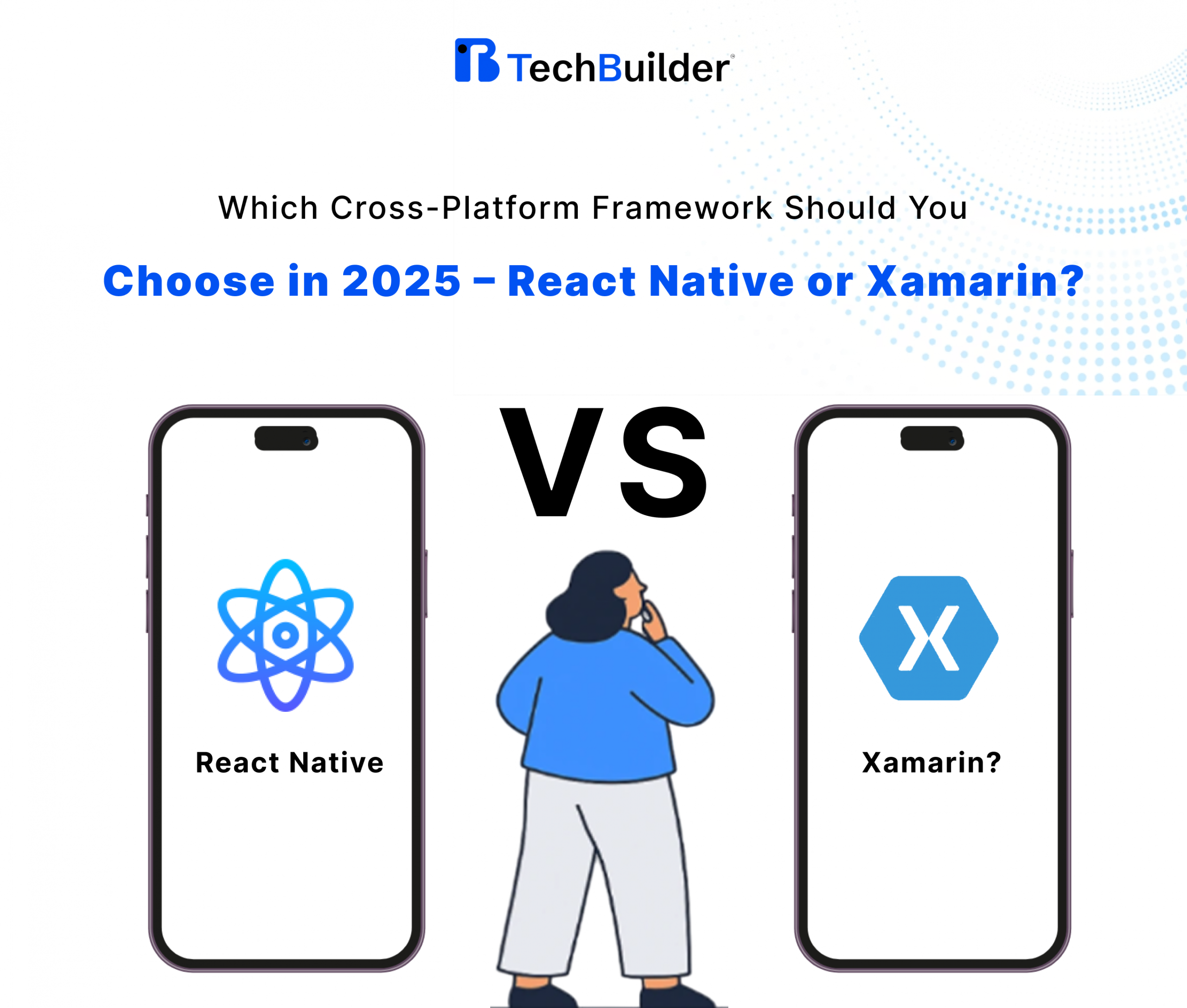The Rise of Cross-Platform Mobile Development in 2025
Did you know that more than 80% of developers today are using – or planning to use – cross-platform frameworks for building mobile apps? Why? Because the cross-platform framework market is growing continuously and is projected to expand from approximately $50 billion in 2025 to over $546 billion by 2033.In this digital era where users are spread across Android, iOS, and future operating systems – choosing the right development framework becomes essential. The framework you pick directly impacts your – app’s performance, cost, maintainability, and user experience. Let’s explore this concept – in more detail.In this blog, we will break down everything you need to know – about React Native and Xamarin. By the end, you will clearly understand:
- What differentiates cross-platform from native development –
- The pros, cons, and ideal use cases for React Native and Xamarin –
- How to decide the best framework for your project –
- What costs and trends to expect moving forward –
So, let’s dive in.
Understanding Cross-Platform vs Native Apps
When building a mobile app, you have two main approaches or options – one is native development and the one is cross-platform development.
Native Apps are built specifically for one platform – for iOS or Android. Using the platform’s own programming languages – like for iOS – Swift/Objective-C and for Android – Java/Kotlin. These apps are designed – for a single platform. Native apps usually offer – better performance, a smoother user experience – and full access to device features. However, building separate apps for each platform can be – time-consuming and expensive.
Cross-Platform Apps are built using frameworks like – React Native or Xamarin. This framework allows you to write one codebase and run it on multiple platforms. This approach reduces development time and cost – while still delivering apps that work on both iOS and Android. While performance may be slightly lower than native apps in some cases – modern cross-platform frameworks have become powerful enough to handle most app requirements efficiently.
In short, we can say –
- Native = is best for performance and platform-specific features.
- Cross-Platform – is best for speed, cost-efficiency – and reaching multiple platforms at once.
Choosing the right approach totally depends on your – project goals, budget, timeline, and user expectations.
What is React Native? Features, Benefits, & Popular App Types
React Native is a popular cross-platform framework developed – by Facebook. It allows developers to build mobile apps – for iOS and Android using a single codebase written in JavaScript.
Key Features –
- Write once, run on both iOS and Android
- Hot reloading for faster development
- Strong community support and a large ecosystem
- Access to native device features like camera, GPS, and notifications
Benefits:
- Faster development and reduced cost
- Easy to maintain one codebase instead of two
- Smooth user experience with near-native performance
- Large pool of developers available
Popular App Types Built with React Native –
- Social media apps – e.g., Facebook, Instagram
- E-commerce apps
- Fintech apps
- On-demand apps like delivery or booking platforms
What is Xamarin? Features, Benefits, & Popular App Types
Xamarin is a cross-platform framework developed – by Microsoft. It allows developers to build apps – for iOS, Android, and Windows using a single C# codebase.
Key Features –
- Single codebase for multiple platforms
- Full access to native APIs and device features
- Integration with Microsoft tools like Visual Studio
- Strong performance close to native apps
Benefits –
- Reduced development – time and cost
- Consistent user experience across platforms
- Easy integration with – enterprise systems and backend services
- Large developer support and corporate backing from Microsoft
Popular App Types Built with Xamarin:
- Enterprise apps for business and productivity
- Healthcare and finance apps
- Apps requiring high security and compliance
- Apps for both mobile and Windows devices
React Native vs Xamarin – How to Choose the Right Framework
Choosing between React Native and Xamarin can be difficult because both frameworks offer the ability to build cross-platform apps – easily and efficiently. The best choice totally depends on your – project requirements, budget, timeline, target audience – and long-term goals. Let’s break it down – step by step.
-
Project Complexity and Type –
React Native is best for apps that – need fast development and frequent updates – such as social media, e-commerce, or on-demand service apps. It works very well for apps that – require a smooth user interface and moderate access – to native device features.
Xamarin is better suited for complex enterprise apps or applications – that require high security, compliance, or integration with Microsoft systems. It is often used for finance, healthcare, or productivity apps – where performance and reliability are critical.
-
Development Speed and Time-to-Market
React Native allows developers to build apps faster – because of hot reloading, a large number of ready-to-use components – and an active community. It’s excellent for startups and businesses – that want to launch quickly.
Xamarin can also save time because of a shared C# codebase – but sometimes integrating native modules can take longer than in React Native. It’s more suitable – if you are aiming for a robust enterprise-grade app.
-
Developer Availability
React Native uses JavaScript – one of the most widely known programming languages. This makes it easier to – find developers and scale your team quickly.
Xamarin uses C#, which may be less common among mobile developers – but is very familiar to developers in the Microsoft ecosystem. If your team already has .NET expertise – Xamarin can be a natural choice.
-
Performance and User Experience
React Native offers near-native performance – but for extremely graphics-heavy apps like advanced games or AR/VR application – it may fall slightly behind.
Xamarin provides performance very close to native apps – because it compiles directly to native code. It’s ideal – if speed and reliability are the top priorities.
-
Budget and Maintenance
React Native can reduce development costs by maintaining a single codebase – for iOS and Android. Frequent updates are also easier to manage.
Xamarin may require slightly higher initial investment – especially if you need enterprise-grade features, but it reduces long-term maintenance – if you are already invested in the Microsoft ecosystem.
-
Ecosystem and Support
React Native has a large, active community, countless open-source libraries – and extensive documentation. Support is widely available online.
Xamarin is backed by Microsoft – with strong documentation, enterprise-level support – and integration with Visual Studio. This makes it ideal – for business-critical applications.
-
Choosing Based on App Goals
Choose React Native if your goals are –
- Faster time-to-market
- Cost efficiency
- Building apps for startups or consumer-facing platforms
- Leveraging a large pool of JavaScript developers
Choose Xamarin if your goals are:
- High performance and reliability
- Enterprise-grade features and security
- Integration with Microsoft systems
- Long-term maintainability with complex apps
There is no “one-size-fits-all” answer. Your choice should be totally based on – project complexity, target audience, timeline, budget, and long-term goals. React Native is excellent for fast, cost-effective development – with a smooth user experience – while Xamarin excels in enterprise applications requiring – performance, security, and Microsoft integration.
Ready To Build Your Next Cross-Platform Mobile App? TechBuilder Is Here To Make It Happen.
Cost Comparison – React Native vs Xamarin in 2025!
When planning a mobile app project – cost is one of the most important factors to consider. Both React Native and Xamarin can save time and money – compared to building separate native apps – but there are differences in development and overall expenses.
React Native is generally more cost-effective – especially for startups and small to medium-sized businesses. The development cost – for a typical React Native app ranges between – $25,000 and $50,000, with the total project cost including – design, testing, and deployment falling between – $30,000 and $60,000. React Native’s large community, pre-built libraries, and faster development cycle – help reduce overall expenses.
Xamarin is significantly more expensive because to its enterprise-level functionality and integration capabilities. The development cost for this app – ranges between – $35,000 to $70,000. The entire project cost – ranges from – $45,000 to $80,000. While it may have greater upfront expenses – Xamarin can be more cost-effective for sophisticated enterprise applications – that demand excellent performance, security, and long-term maintainability.
In short, React Native is more cost-effective for most projects – whereas Xamarin is a superior investment for enterprise-level apps that value dependability and integration over initial cost.
Cost Comparison (2025 Estimate)
| Framework | Development Cost Range | Total Project Cost (Incl. Design, QA) | Ideal Users | Total Cost at TechBuilder |
| React Native | $25,000 – $50,000 | $30,000 – $60,000 | Startups, SMBs | $20,000 – $40,000 |
| Xamarin | $35,000 – $70,000 | $45,000 – $80,000 | Enterprises, Corporates | $30,000 – $60,000 |
Use Cases – When to Choose React Native and When to Choose Xamarin!
Choosing the right framework totally depends on – the type of app you want to build – your target audience – and your business goals. Here’s a clear breakdown of – when React Native or Xamarin – is the better choice.
When to Choose React Native
-
Startups & MVPs – Minimum Viable Products:
If you’re a startup or developing an MVP – speed and cost efficiency are crucial. React Native enables you to – develop apps faster – using a single codebase for both – iOS and Android. This allows you to launch rapidly – test your idea in the market – and iterate depending on user feedback – without spending a lot of money on individual native apps.
-
Social Media & Consumer-Facing Apps
React Native is perfect for apps – that rely heavily on smooth user interfaces and frequent updates. Examples include – social networking apps, messaging platforms, or content-sharing apps. Its ability to deliver near-native performance – with visually appealing UI makes it a – great choice for apps where user engagement is key.
-
E-Commerce and On-Demand Applications
Apps that manage shopping, food delivery, ride-hailing – or booking services benefit – from React Native’s rapid development and extensive library of pre-built components. You can instantly incorporate features such as – payment gateways, push alerts, and geolocation services – without having to create different apps for each platform.
-
Apps with frequent updates
If your app receives frequent feature updates or modifications – React Native’s quick reloading functionality enables developers – to implement and test changes in real time. This ensures that your software – is constantly updated and responsive to user needs.
When to Choose Xamarin –
-
Enterprise Applications
Xamarin is suitable for developing enterprise-grade apps – with high security, complicated processes, and integration with existing systems. Companies in banking, healthcare, and logistics frequently pick Xamarin – because of its strong security requirements and scalable architecture.
-
Apps Requiring High Performance
If your app relies on heavy processing, complex calculations, or advanced device features – Xamarin’s ability to compile into native code provides performance very close to native apps. This is important for – apps like banking systems, medical apps, or professional productivity tools.
-
Cross-Platform Applications for the Microsoft Ecosystem
Xamarin is strongly integrated – with Microsoft’s tools and services. If your app has to connect with Azure – Microsoft 365, or Windows devices – Xamarin provides seamless connectivity and uniform functionality – across all platforms.
-
Long-term Maintenance and Consistency
For applications that are expected – to run and scale for many years – Xamarin provides excellent maintainability – with a single C# codebase and enterprise-level support. This ensures consistency, simplifies updates – and reduces long-term technological debt.
React Native is best suited – for startups, consumer apps, e-commerce, and apps – that require speed, cost-effectiveness, and frequent upgrades. Xamarin is ideal for enterprise applications that – demand high performance, security, and interaction – with Microsoft services – as well as projects – that value long-term dependability. This clear understanding of use cases will help businesses – make the right framework choice based on their goals and resources.
Future Outlook – React Native and Xamarin Beyond 2025
The mobile app development landscape – is constantly evolving – and cross-platform frameworks are only becoming more powerful.
React Native is expected – to continue growing in popularity – due to its large community, frequent updates, and flexibility. With new tools and libraries – it will become even easier to build – high-performance apps quickly, making – it a strong choice for startups and consumer apps.
Xamarin, backed by Microsoft – will remain a preferred choice – for enterprise applications and apps requiring tight integration with Microsoft ecosystems. With ongoing updates and support – Xamarin will continue to provide – robust, secure, and scalable solutions – for complex projects.
In the coming years – businesses can expect faster development – better performance, and more efficient maintenance from both frameworks. The choice will increasingly depend on the – project type, budget – and long-term goals.
Conclusion – Making the Right Decision for Your Mobile App Strategy!
Choosing the right framework – React Native or Xamarin – is crucial for the success of your mobile app. Both have unique strengths –
React Native is ideal for faster – cost-effective development and apps – with frequent updates.
Xamarin is best for enterprise-level, high-performance apps – that require security and integration with Microsoft systems.
At TechBuilder – we help businesses turn ideas into high-quality mobile apps – using the framework that best fits their needs. Whether it’s a consumer app, enterprise solution, or on-demand platform – our team delivers apps that perform, scale, and delight users. Contact us today to discuss your project – and get started on building your next mobile app.
FAQs
- What is the main difference between React Native and Xamarin?
React Native uses JavaScript and is ideal for fast, consumer-facing apps, while Xamarin uses C# and is better suited for enterprise and high-performance applications.
- Which framework is more cost-effective?
React Native is generally more budget-friendly, with lower development and total project costs, while Xamarin can be slightly more expensive due to enterprise features.
- Can I maintain one codebase for both iOS and Android?
Yes, both React Native and Xamarin allow you to write a single codebase that runs on multiple platforms, saving time and cost.
- Which is better for startups?
React Native is usually the better choice for startups due to faster development, lower costs, and easier updates.
- Which is better for enterprise apps?
Xamarin is preferred for enterprise apps requiring high security, integration with Microsoft systems, and long-term maintainability.
- Will these frameworks remain relevant in the future?
Yes, both React Native and Xamarin are continuously evolving and are expected to remain strong options for cross-platform development beyond 2025.





































































